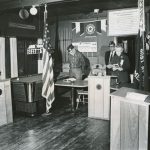Founded in 1980, Living Free Animal Sanctuary was among the first privately funded no-kill animal sanctuaries, with a mission of rescuing cats and dogs from imminent shelter euthanasia.
And in an effort to better acquaint the mountain communities with Living Free’s mission, the board has inaugurated “town meetings,” prior to board meetings. The next meeting is at Meadow House on the Living Free campus, Sat. March 7 from 10 to 11 a.m. “We’re wide open to having the town attend these sessions, to ask questions and get to know us,” said President Randall Harris. “We want to be part of the community and less isolated.”
He noted the board is now more involved in creating policy and in day-to-day management. As part of that, there is a concerted move to increase public awareness within the mountain communities and off-Hill through more outreach, new branding, and website and social media campaigns. “We’re committed to full transparency in how we operate,” said Harris. “Now 82 cents of every dollar we take in goes to animal-related services.
“We’re also working more closely with ARF. There is no competition. One thing we have is no shortage of is animals who need help,” said Harris.
Policy changes at Living Free have increased pet adoption rates, according to Harris. “Last year we broke adoption records for our 34-year history,” said Harris. Staff now has more discretion in matching pets with prospective owners, leading to higher adoption rates. Whereas in previous years, 25 cats and dogs might have been adopted in a single year, last year more than 200 animals found permanent homes.
Minor changes in adoption guidelines have made the difference, said Harris. Previous guidelines required a home to have a 6-foot fenced yard with a specified amount of space. “Now, there is a small-dog exception,” said Harris, so smaller dogs can be adopted. “It’s now on a case-by-case basis,” Harris noted. “We will try to find a match for you.” He stressed some fixed guidelines that cannot be altered, such as forbidding de-clawing of cats or allowing them to be adopted into mountain homes where they’re allowed to go outdoors.
Also adding to increased adoptions, Harris cited construction of a puppy quarantine facility and a “kittery,” allowing LF to take in young puppies and kittens and keep them isolated, monitored and medically treated until ready for adoption. “We dedicated a chunk of resources to building these new facilities so we could take in these young animals,” he said.
Harris said LF rescues animals from kill shelters, saving them from euthanasia. “For every animal you adopt from Living Free, you save two lives — the one you take home and the one that can now fill the space your compassion has created,” he said. Www.living-free.org notes that each year, 7 million cats and dogs are abandoned to shelters and 4 million killed. The 4 million represent 3 percent of animals bought annually from breeders, retailers and puppy mills. If that 3 percent were rescued animals rather than ones purchased, there would be no euthanasia, says the site.
“We have developed educational outreach programs to promote responsible pet ownership. We are collaborating with other organizations to help end the need for healthy animal euthanasia by increasing public awareness of the need to eradicate inhumane puppy and kitten mills,” said Harris.










